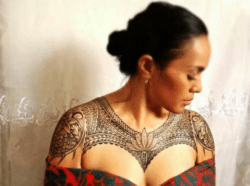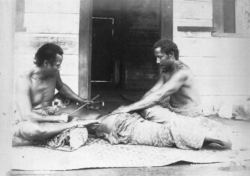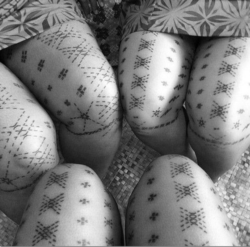Written on the body

This article is brought to you by Travel Samoa.
Samoan culture is steeped in tradition, from delicious food and melodious song to the extraordinary tattoos with which both the men and women of this South Pacific paradise are adorned.
Before you visit, here’s a fascinating insight into these detailed works of art, known as ‘tatau’, and why they’re such a vital part of island life.
In Samoan communities, men traditionally receive markings called a pe’a from mid-torso to knees as a marker of maturity. Women receive a thigh tattoo, called a malu.
Tatau has made forays into other cultures while retaining its traditional Samoan flair, and its influence stretches well beyond its native islands. Samoans have mainly migrated to the United States, New Zealand and Australia, and people of Samoan ancestry now use tattoos to connect with their roots. Tatau masters have visited a variety of nations to create their distinctive art for clients, both Samoan and non-Samoan, including other Pacific islands where they’ve helped revive lost tattoo practices.
“It’s amazing [tatau’s] persisted,” says anthropologist Sean Mallon, the senior curator of Pacific cultures at the Museum of New Zealand Te Papa Tongarewa. “I can’t believe it, in a way.”
Many possible reasons can explain the practice’s resilience. As with tattoos the world over, tatau’s power rests in part in how various groups read and recognise these markings. Traditionally, Samoan tattoos marked adulthood, which came with special privileges. Christian missionaries, when they came to the archipelago, never caught on to the rite’s religious dimension, so they didn’t perceive it as a direct threat to their churches. As a result, tatau persists today, and its meaning has only broadened with Samoan migration.
The tatau tradition goes back 3000 years. But when missionaries first encountered it, two centuries ago, they considered it a “savage and heathen practice” says Mallon. As a result of tattoo taboos, some Samoans risked fines or banishment for getting inked.
For instance, the London Missionary Society, which arrived on Savai‘i Island in the western part of Samoa in 1830, banned tatau in some areas because it disapproved of the partying that often accompanied the process. But island geography helped thwart their efforts, notes Sébastien Galliot, an anthropologist at the French National Centre for Scientific Research, Centre for Research and Documentation on Oceania in Marseille, France.

Samoa is an archipelago, comprising several islands and islets. At the time, it had a “decentralised system of chieftainship,” says Galliot. The society converted a few villages, but others were relatively unaffected. That fact gave tatau plenty of space for continued practice.
When chiefs in eastern parts of Samoa banned tatau in the 1860s, young men travelled to the western end of the archipelago to get tattooed, even though it meant they couldn’t go home. They were allowed back by the 1890s—provided they paid a fine.
Meanwhile, Catholic missionaries, who arrived in 1845, ended up accepting the tatau tradition. They sent a letter to church leaders in Rome, arguing that the practice wasn’t religious, and received dispensation to allow tattooing among converts.
But the Catholics may have been mistaken, explains Galliot, who collaborated with Mallon on a history of tatau. In reviewing historic documents, Galliot discovered that a local shrine was linked to the legendary sisters, Taema and Tilafaiga, who are credited with bringing tatau to Samoa. That connection, says Galliot, was “a point that none of the missionaries had actually figured out.”
During a traditional ritual, tattoo artists ink the pe’a in a special order, working across specific zones of the body in stages.
As a result of these varied factors, Samoans held on to tatau even as they broadly adopted Christianity. In fact, some Christian leaders now embrace tattooing. In modern Samoa, a pastor or preacher often kicks off the tattooing process by sanctifying the place where it will happen. Mallon notes that his uncle, who was a priest in Samoa, had a pe’a.
Other factors are also at play in tatau’s survival. Undergoing the ritual gave Samoans things they weren’t willing to give up for the missionaries’ God: status, evidence of strength and courage, and improved desirability to potential partners.
The pe’a is an important rite of passage in Samoan communities that grants a man adult status and the right to perform certain duties for the village chief. “You’re not respected without your tatau,” explains Si’i Liufau, a Samoan tattoo artist in Garden Grove, California. “You have to have a tatau to be a full man.” Today many people save up until midlife to afford the expensive ritual.
For women, the malu (below) also brings privileges. For example, tattooed women can serve ceremonial drinks or collect gifts at a funeral. Some women now get the malu to mark life events such as university graduation or a job promotion.

Anthropologists have found that across diverse cultures, tattooing is a way to advertise or emphasise one’s identity. Tatau follows the pattern. “Tattooing is still something important in a man’s life or in a woman’s life in terms of marking their belonging to the community,” Galliot says.
To many people of Samoan ancestry living around the world, tatau provides a sense of connection to their ancestral islands. For instance, it helps people identify as Samoan as opposed to other groups such as Maori or Tongan.
Liufau, who grew up in Southern California, discovered Samoan tattooing in his 20s. Tatau brought him back to Samoan traditions and language as he trained to perform the ritual himself.
“This is something we’ve had since the beginning of being Samoans,” says Liufau. “Churches might change, but Samoan culture does not.”
For more on these beautiful pieces of body art, and to experience the incredible culture of Samoa visit Travel Samoa.
This article is brought to you by Travel Samoa.

